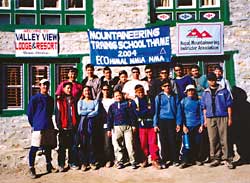 Nepali climbers set new records this season on Sagarmatha and other Himalayan peaks. Forty-three of the 75 people who climbed Sagarmatha this year from the Nepal side till presstime Wednesday were Nepalis. An increasing number of Sherpas do not regard climbing as just a job any more, but as an adventure and a challenge.
Nepali climbers set new records this season on Sagarmatha and other Himalayan peaks. Forty-three of the 75 people who climbed Sagarmatha this year from the Nepal side till presstime Wednesday were Nepalis. An increasing number of Sherpas do not regard climbing as just a job any more, but as an adventure and a challenge. Although they appear to be genetically able to adapt to high altitude, most Nepali climbers lack technical training. This is also the reason for the casualty rate among high altitude porters who need to learn more about rope and ice techniques and objective dangers.
Nepal Mountaineering Association (NMA) set up a climbing school in Manang 15 years ago to conduct regular training. A group of veteran Nepali climbers have also formed the Nepal Mountaineering Instructor Association (NMIA) to encourage Nepal's youth to discover the wilderness, learn basic climbing techniques and undergo survival training.
Austrian group Eco-Himal has been working with both organisations to standardise and institutionalise mountaineering training in Nepal and promote sustainable and viable eco-tourism models. It just completed a one-month training in first aid, rock climbing, ice techniques and mountain rescue in Thame.
"I have been guiding climbing groups, but was self-taught. It is better to be trained," says Krishna Gurung, who took the course last year.
The course in Thame was designed by NMIA along internationally-recognised norms so that Nepal-trained guides and climbers can now join international expeditions as more than just porters. "This training will give our trainees the same grade as the internationally-recognised UIAGM," says NMIA's Nima Sherpa who has been training Nepali climbers in Thame for the past seven years, referring to the Union Internationale des Associations de Guides de Montagne.
 "UIAGM-recognised training is a great asset for a Nepali climber or guide," says Herbert Mayerhoefer, a mountaineering instructor from Austria. "This can be a big boost to mountaineering tourism and this training must be recognised by the Nepal government as well."
"UIAGM-recognised training is a great asset for a Nepali climber or guide," says Herbert Mayerhoefer, a mountaineering instructor from Austria. "This can be a big boost to mountaineering tourism and this training must be recognised by the Nepal government as well." Four slots in the annual training are set aside for women, and every year all are taken. "My husband took the course last year, and since I am also a mountain guide, I am here to prove myself," says Mendo Sherpa. More and more women are joining the industry as trekking and high-altitude guides. Eco-Himal also organises all-women trekking training camps at Annapurna Base Camp. "It is fantastic exposure for our women guides, and they benefit a lot," says Ngimi Sherpa, who coordinates Eco-Himal's female trekking guides training.
True to its name, Eco-Himal also focuses on eco-friendly trekking and mountaineering: there is a lot of training in toilet construction, alternate fuel use and even development aspects like micro-hydro power, village drinking water systems and suspension bridge-building. "The idea is to make people use income from tourism to plan their own development so they don't have to depend on foreign aid," says Max Santner, Eco-Himal's regional director.
 NMIA is translating its mountaineering training handbooks into Nepali so that trainees as well as porters who don't know English can learn technical aspects like fixed rope climbing, glacier traversing, search and rescue and altitude sickness guidelines.
NMIA is translating its mountaineering training handbooks into Nepali so that trainees as well as porters who don't know English can learn technical aspects like fixed rope climbing, glacier traversing, search and rescue and altitude sickness guidelines. Appa Sherpa, who climbed Sagarmatha for a record 14th time this year, never got any formal training but underlines its importance. The trainees ran into him at base camp as he was preparing for yet another ascent. He told them: "Unlike us, the younger generation of guides are all very well trained in ice and rock climbing and this is a great help up on the mountain."


